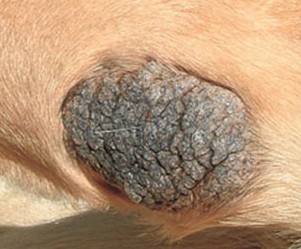Table of Contents
Summary | Causes | Symptoms | Treatment and Prevention | When to See a Vet
Summary:
"Callus pyoderma is common among dogs. Decubital ulcers or pressure sores are open wounds that form due to chronic pressure in one spot. Eventually, pressure caused by leaning against solid surfaces such as porches or floor can cause dog elbow calluses or calluses in other locations to form such as at the waist, shoulders, and sides of the legs.
Pressure sores can crack and bleed and can be infected if left infected by calluses at the elbow joints.
Pressure sores are generally red in the center, with pink around the edges, and resist healing. When rough skin forms, it may ooze if an infection is present. Treatment may include bandages, laser therapy to stimulate healing, and antibiotics. Dogs with pressure sores must be kept on thick, padded bedding and repositioned every two to four hours.
Without treatment, secondary infection is common. It is easy to diagnose the condition, and it isn't very easy to treat. Pet parents are crucial in treating calluses and preventing proliferation. The condition is frequently seen in giant breed dogs, although it can be a problem for any dog.
Most calluses do not cause a problem. However, in some cases, the callus will develop an infection, in which case a veterinarian should evaluate it. If left untreated, the calluses will crack and burn, causing a laceration. In addition, if left untreated, the pressure sore becomes likely to be infectious."

Why Do Some Dogs Get Elbow Calluses
A dog elbow callus is the most common place for a canine callus to appear. A callus occurs when the dog's ulna and other bones contact the ground. The pain of sustaining constant pressure on the skin can cause permanent damage and thicken it. The ulna does its best to protect itself, but the result is dogs that develop calluses. The callus or skin gets thicker each time it touches the floor to protect the bone.
In warmer climates, hard surfaces are typically cooler for large dogs, giving rise to the problem. Heavy coated giant breeds typically don't have elbow calluses to the degree that their shorter coated cousins do, as their coat softens the friction of the elbow against the ground. For example, the British Mastiff is less likely to develop callus elbows than is its short coat cousin, the Newfoundland chameleon.
The pain of sustaining pressure to the skin can cause permanent damage and thicken it. The Ulna bone does its best to protect itself, but the result is the callus. The callus gets thicker each time they touch the floor, and the bone is protected by the skin, making it thicker.
When To Be Concerned and Symptoms
Repeated trauma to the area, such as to dogs elbows, can cause the elbow calluses to crack, creating an ideal site for infection. Signs of an infection include oozing, bleeding, redness, soreness in that limb, and the callus and surrounding skin feeling warm to the touch. Flaky, scaly skin is also a sign that something is amiss. Your veterinarian will likely prescribe an antibiotic and a topical ointment.
Chronically infected calluses can progress to callus pyoderma, characterized by ulceration and oozing of the skin. This may be an irritated callus or something more sinister such as a fungal infection, mite infection, impacted hair follicle, or cancer.
A hygroma is a fluid-filled pocket that may form under or near a callus. You can try treating a hygroma at home by alternating cold and warm compresses (5 to 10 minutes each) multiple times a day. However, if the hygroma does not become smaller after a few days or feels warm to the touch before you apply a warm compress, your veterinarian may need to drain it.
Treatment and Prevention
The best course of action is to prevent callus formation by providing soft beds or blankets on a hard surface. That being said, some dogs prefer to lie on the concrete or hardwood floors rather than use the beds provided by their owners. Confining your dog to an exercise pen can help, or try different types of dog beds to see what your dog prefers and place them in locations where he likes to lie.
If you can't get your dog to use a softer spot to rest, use of a softer dog bed might be the right way to go. The use of topical softening products should not be the only approach used. Only use topical softening products if you also address the elimination of any hard surface. If you can eliminate contact with hard surfaces and there's no infection, some over-the-counter options like Blissful Dog Elbow Butter, Bag Balm, plain aloe, and unscented butter balms can help soothe irritation. Apply the balm to your dog's callus 2x to 3x a day. To avoid licking of the balm, apply before a walk or meal, which can distract your dog from the elbow butter or balm. This will also give the balm time to penetrate the callus.
When Should I See a Vet
When a callus is has visible bleeding, is causing discomfort or is irritation, you should see a veterinarian and not treat at home.
